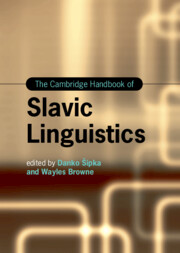Book contents
- The Cambridge Handbook of Slavic Linguistics
- Cambridge Handbooks in Language and Linguistics
- The Cambridge Handbook of Slavic Linguistics
- Copyright page
- Contents
- Figures
- Tables
- Contributors
- Introduction
- Part 1 Prosody and Phonology
- 1 Word Stress
- 2 Vocalism: The Vowels
- 3 Consonantism: The Consonants
- 4 Syllable Structure
- 5 Phonologically Conditioned Alternations
- 6 Prosodic Reflexes of Information Structure
- Part 2 Inflectional and Derivational Morphology
- Part 3 Syntax
- Part 4 Lexicon
- Part 5 Sociolinguistic and Geographical Approaches
- Part 6 Experimental and Quantitative Approaches
- Name Index
- Subject Index
- References
1 - Word Stress
from Part 1 - Prosody and Phonology
Published online by Cambridge University Press: 16 May 2024
- The Cambridge Handbook of Slavic Linguistics
- Cambridge Handbooks in Language and Linguistics
- The Cambridge Handbook of Slavic Linguistics
- Copyright page
- Contents
- Figures
- Tables
- Contributors
- Introduction
- Part 1 Prosody and Phonology
- 1 Word Stress
- 2 Vocalism: The Vowels
- 3 Consonantism: The Consonants
- 4 Syllable Structure
- 5 Phonologically Conditioned Alternations
- 6 Prosodic Reflexes of Information Structure
- Part 2 Inflectional and Derivational Morphology
- Part 3 Syntax
- Part 4 Lexicon
- Part 5 Sociolinguistic and Geographical Approaches
- Part 6 Experimental and Quantitative Approaches
- Name Index
- Subject Index
- References
Summary
This chapter addresses word stress patterns in Slavic languages. The discussion focuses on the placement of stress and the nature of the accent. Fixed stress systems are discussed (initial, antepenultimate, penultimate) as well as systems with free stress. The chapter also discusses the movement of the stress within inflectional patterns. The discussion furthermore includes the nature of the stress in various Slavic languages. There is also an outline of the laws regulating the patterns of stress in Slavic languages.
- Type
- Chapter
- Information
- The Cambridge Handbook of Slavic Linguistics , pp. 9 - 28Publisher: Cambridge University PressPrint publication year: 2024

